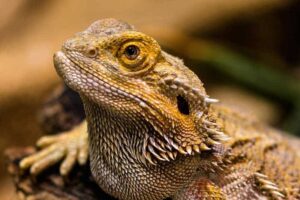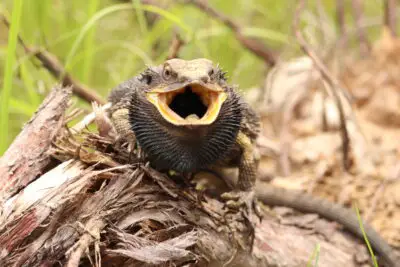Curious about the quirky behaviors of our scaly companions, especially when it comes to their vocal expressions? Well, let’s dive into the fascinating world of bearded dragons and explore the intriguing question: do bearded dragons hiss?
Yes, bearded dragons are known to exhibit hissing behavior. Hissing is one of the communication methods employed by these fascinating reptiles. When a bearded dragon hisses, it often signifies feelings of discomfort, fear, or a desire to establish dominance. It’s their way of expressing displeasure or warning others, including potential threats, to keep their distance.
The bottom line is that these enchanting reptiles have a unique way of communicating, and understanding the reasons behind their hissing could provide valuable insights into their behavior. So, buckle up as we embark on a journey to unravel the mysteries behind the hisses of our beloved bearded dragons.
Do bearded dragons hiss?

Yes, bearded dragons can hiss. Hissing is a common behavior in bearded dragons, and they may do it for various reasons. It can be a sign of stress, fear, or discomfort. If a bearded dragon feels threatened or cornered, it may hiss as a warning to deter potential predators or perceived threats.
It’s essential to pay attention to your bearded dragon’s body language and behavior to understand the reasons behind the hissing. If your bearded dragon is consistently hissing or showing signs of stress, it’s crucial to assess its environment, handling, and overall well-being to ensure it is comfortable and healthy.
Why do Bearded Dragons Hiss?
Bearded dragons may hiss for several reasons, and understanding the context can help you address their needs and minimize stress. Here are common reasons why bearded dragons may hiss:
- Fear or Threat Perception: Hissing is a defensive behavior. If a bearded dragon feels threatened, cornered, or frightened, it may hiss as a warning to ward off potential threats.
- Territorial Behavior: Bearded dragons can be territorial, especially during breeding seasons or if they feel their space is invaded. Hissing may occur as a way to establish dominance or protect their territory.
- Discomfort or Pain: If a bearded dragon is experiencing discomfort or pain, it may respond with hissing. Health issues, such as impaction or injury, could contribute to this behavior.
- Handling Stress: Some bearded dragons may hiss when they are uncomfortable with being handled. If they are not used to human interaction or are feeling insecure, they may express their displeasure through hissing.
- Mating Behavior: During the breeding season, male bearded dragons may hiss as part of their courtship behavior. This is often accompanied by other behaviors like head bobbing and displaying.
- New Environment or Changes: If a bearded dragon is introduced to a new environment or experiences significant changes in its surroundings, it may react with hissing as a response to stress.
It’s crucial to observe your bearded dragon’s body language, context, and overall behavior to determine the cause of the hissing. If the hissing persists or is accompanied by other concerning behaviors, it’s recommended to consult with a veterinarian specializing in reptile care to rule out any health issues and ensure your bearded dragon’s well-being.
Understanding Bearded Dragon Body Language
Bearded dragons, like many reptiles, communicate through body language. Understanding their body language can help you better care for and interact with your pet. Here are some common bearded dragon behaviors and their meanings:
- Head Bobbing:
- Male Aggression/Display: Male bearded dragons may bob their heads to establish dominance, especially during the breeding season. This is a territorial display.
- Submission: Females or less dominant dragons may head bob as a sign of submission.
- Arm Waving:
- Submissive Gesture: Bearded dragons may wave one of their front limbs as a submissive signal, especially in the presence of a more dominant dragon. This is often seen in females.
- Flattening Body:
- Submission or Cooling Down: Flattening of the body can be a submissive gesture, but it can also be a way for the dragon to cool down and absorb more heat.
- Black Beard (Beard Darkening):
- Stress or Aggression: When a bearded dragon’s beard turns black, it can indicate stress, fear, or aggression. This could be due to environmental factors or perceived threats.
- Gaping Mouth:
- Thermoregulation: Gaping is a way for bearded dragons to regulate their body temperature. It helps them cool down, especially when basking.
- Basking and Sunning:
- Normal Behavior: Basking is a natural behavior for bearded dragons. They need access to a heat source to regulate their body temperature effectively.
- Tail Position:
- Content or Relaxed: A raised tail can indicate a content or relaxed dragon, while a lowered tail may signal submission or discomfort.
- Puffing Up:
- Fear or Threat: Bearded dragons may puff up their bodies to appear larger when they feel threatened. This can be a defensive posture.
- Licking or Nudging:
- Exploration: Bearded dragons may use their tongues to explore their surroundings. Nudging can be a sign of curiosity.
- Digging:
- Nesting or Burrowing: Female bearded dragons may dig to create a nest for laying eggs. Both males and females may dig as a natural behavior.
- Glass Surfing:
- Stress or Restlessness: Bearded dragons may “surf” against the glass of their enclosure if they are stressed, feeling confined, or if they see their reflection.
Observing your bearded dragon regularly and paying attention to its body language will help you understand its needs and emotions. Always ensure that your dragon’s habitat meets its environmental requirements for temperature, lighting, and substrate to promote a healthy and comfortable lifestyle.
How to Respond to a Hissing Bearded Dragon

A hissing bearded dragon is likely feeling threatened, scared, or stressed. It’s essential to respond calmly and appropriately to avoid escalating the situation and to help your bearded dragon feel more secure. Here are steps you can take when faced with a hissing bearded dragon:
- Stay Calm:
- Avoid sudden movements or loud noises. Approach your bearded dragon slowly and calmly to avoid further stressing it.
- Identify the Cause:
- Try to determine what might be causing the hissing. Common triggers include feeling cornered, being handled too roughly, or perceiving a threat in the environment.
- Give Space:
- If your bearded dragon is hissing, it’s trying to communicate discomfort or fear. Respect its signals and give it some space. Retreat to a safe distance and allow the dragon to calm down.
- Assess the Environment:
- Ensure that the habitat is providing the appropriate conditions, including proper temperature, lighting, and hiding spots. An inadequate environment can lead to stress.
- Avoid Punishment:
- Bearded dragons do not respond well to punishment. Instead of scolding or punishing the dragon, focus on creating a positive and stress-free environment.
- Handle with Care:
- If you need to handle your bearded dragon, do so gently and confidently. Approach from the side rather than from above, which can be perceived as threatening. Let the dragon come to you if it feels comfortable.
- Check for Health Issues:
- If your bearded dragon’s behavior changes suddenly or if it continues to be defensive, it may be worth consulting with a veterinarian. Health issues, such as pain or illness, could be contributing to the behavior.
- Establish Trust:
- Spend time near the enclosure without attempting to handle the dragon. Let it get used to your presence, and use positive reinforcement, such as offering treats, to associate you with positive experiences.
- Create a Safe Environment:
- Make sure the enclosure provides plenty of hiding spots and a secure feeling for your bearded dragon. This helps reduce stress and allows the dragon to retreat when it feels threatened.
- Regular Interaction:
- Gradually increase the frequency and duration of your interactions. This helps build trust over time. Always monitor your bearded dragon’s body language and adjust your approach accordingly.
Remember that each bearded dragon is unique, and it may take time for your pet to feel comfortable and secure in its environment. Patience, consistency, and gentle handling are key to building a positive relationship with your bearded dragon. If concerns persist, seeking advice from a reptile-savvy veterinarian is advisable.
When to seek assistance from a reptile behaviorist
Seeking assistance from a reptile behaviorist can be beneficial when you’re dealing with specific behavioral issues or challenges with your bearded dragon or other reptiles. Here are situations in which you might consider consulting a reptile behaviorist:
- Aggressive Behavior:
- If your bearded dragon is displaying consistent aggression, including biting, lunging, or other defensive behaviors, a behaviorist can help identify the underlying causes and develop a plan to address the aggression.
- Excessive Stress or Fear:
- Continuous signs of stress, such as hiding constantly, refusing to eat, or exhibiting signs of fear, may indicate an issue that a behaviorist can help address.
- Refusal to Eat:
- If your bearded dragon consistently refuses to eat or shows a sudden loss of appetite, there could be underlying health or behavioral issues that a professional can assess.
- Reproductive Issues:
- Unusual behaviors related to reproduction, such as excessive aggression during the breeding season or difficulty with egg laying, may require the expertise of a behaviorist.
- Environmental or Husbandry Problems:
- If you’re having difficulties maintaining the proper habitat conditions or your bearded dragon’s enclosure needs adjustments, a behaviorist can offer guidance on creating a suitable environment.
- Unusual Movements or Postures:
- If your bearded dragon exhibits abnormal movements, postures, or spasms, it could be indicative of a health or behavioral issue that requires professional evaluation.
- Excessive Hiding:
- While some hiding is normal for bearded dragons, excessive hiding can be a sign of stress or illness. A behaviorist can help determine the cause and recommend solutions.
- Difficulty with Handling:
- If your bearded dragon consistently resists handling or displays extreme stress during interactions, a behaviorist can provide strategies to build trust and make handling a positive experience.
- Chronic Agitation or Restlessness:
- If your bearded dragon is constantly agitated or restless, there may be underlying issues that a behaviorist can help identify and address.
- Communication Issues:
- If you’re having difficulty interpreting your bearded dragon’s body language or understanding its needs, a behaviorist can educate you on reptile behavior and communication.
When choosing a reptile behaviorist, look for someone with experience working specifically with reptiles, preferably bearded dragons. They can conduct a thorough assessment of your pet’s environment, diet, and behavior to determine the root causes of any issues.
Additionally, if there are concerns about the health of your bearded dragon, it’s crucial to consult with a reptile-savvy veterinarian in conjunction with seeking behaviorist assistance.
Conclusion
This page answers the question on do bearded dragons hiss. Hissing is a part of their communication behavior and is often associated with feelings of discomfort, fear, or stress. Understanding the reasons behind their hissing can help owners provide appropriate care and create a comfortable environment for their bearded dragons.

